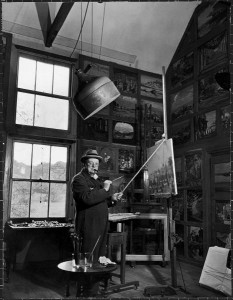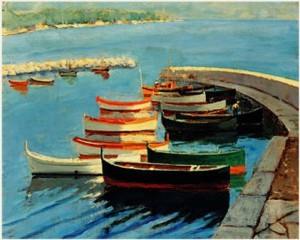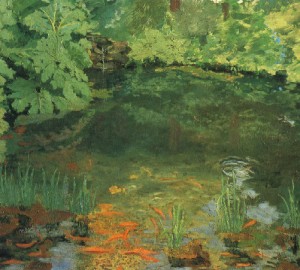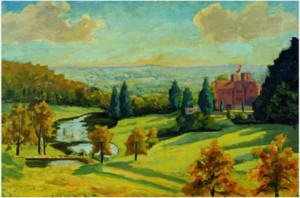Winston Churchill, Painter
Register now for the 2013 Winston S. Churchill Symposium in New Orleans!
The philosopher Isaiah Berlin wrote that Churchill was “the largest man of our times,” and a brief acquaintance with Churchill’s long life and career bears out this claim. In his lifetime Churchill was a heroic war leader and Prime Minister, a foot soldier and a First Lord of the Admiralty, a Member of Parliament and a Chancellor of the Exchequer. He played polo, hunted big game in Africa, and gambled in Monte Carlo; he was a loving husband and an indulgent father. Before he was forty he saw war as a journalist in Cuba, as a cavalry officer in Sudan, and was a POW in South Africa. He modernized the prewar Navy and served as an officer in the Great War trenches in France. He was a noted historian and won the Nobel Prize for literature.
But politics and writing were ultimately serious work and business for Churchill. Writing served to promote and support his political life; it was an extension of his career and influence. While he proliferated in both pathways, success did not always come easily. In particular, writing extracted effort on his part, and was a necessary employment for the financial support of his family. He enjoyed the delights of conversation and the dinner table, but these were also tied to his career interests. Being passionately devoted to his career, he did not engage in hobbies which appeared to have little utility in promoting his career efforts.
After the failure of the Gallipoli campaign appeared to have ended his political career in 1915, the “Muse of Painting” appeared to rescue Churchill from his deepest bout of “Black Dog” (the nickname he gave his deep depressions). His cousin introduced him to watercolors while in the garden at Hoe Farm. Churchill at first timidly attempted to apply paint to the canvas; when he realized that the canvas would not strike back, he entered whole-heartedly into the effort. Being Winston Churchill, a man who did things for history, naturally he early began to paint in oils. Painting was the one activity which he did for the sheer pleasure, enjoyment, and challenge of the art, and without a political motive. It claimed his attention for the rest of his life, and was perhaps the surest method he had of relaxation.
Painting was not a frivolous delight to Churchill. Painting appealed to a very deep element in his personality, a serious and meaningful key to his being. Painting connected Churchill to the pursuit and creation of beauty in the world. Churchill the painter was a different man than the world had become accustomed to know. In this field, he eagerly sought advice and consultation, and was willing to take direction from others. In his political and literary talents, he was the supreme judge. But in his attitude towards painting, Churchill not only subordinated his will, but submitted to an inner light and higher power.
In the opinion of this writer, Churchill the painter communed and connected closely with an inner religious or philosophical spirit. He was not a practitioner of any orthodox religious faith. However, as a young man he had become aware of gaps in his knowledge and education which he had assiduously set out to correct. As a young subaltern in India, he had spent long hours reading in ancient history and philosophy. His readings in Gibbon and the Greek philosophers exposed him to the classical ideals of truth, beauty, and the good. These he sought in his painting through his explorations of colors and nature.
Churchill the painter became quite committed and accomplished in his hobby. He eventually built a painting studio on the grounds of his home. In the mid-1920s, Churchill anonymously submitted some of his work to a public exhibit, where he gained recognition from some of Britain’s leading art critics (who were surprised when they learned the identity of the artist). One of the critics observed that Churchill painted from a deep, calm part of his soul.
This was an accurate insight. Painting was the one activity that he performed completely in silence, and it melted away his anxieties, allowing him to lose himself in the study of colors and nature. Churchill did not paint pictures which connected to his political or military life, such as portraits of his contemporaries. With the exception of a few early canvases from his wartime service at “Plug Street” in France, as his troops referred to their headquarters, he did not paint scenes of violence, death or war. He preferred landscapes and seascapes, full of color and natural life. He painted nature: mountains, seas, sunsets, forests, rivers. When man did intervene in Churchill’s paintings, it was usually in the form of an artwork: a china Buddha, a stone sculpture in a windswept garden, ancient Roman aqueducts and Greek ruins, bridges spans crossing waters, boats awaiting to set sail. And he painted the personal things which adorned the central pleasure of his life: his home. He painted few portraits, but painted those he loved, such as his wife Clementine. He painted the flowers, bottles, and vases which adorned his beloved house, Chartwell, especially the landscapes surrounding the house and overlooking the weald of Kent.
A man in a hurry most of his life, the muse of painting stilled and becalmed Churchill’s sense of the passage of time and life, of the movements of history. It centered and brought out his spiritual conviction of the immutability of nature, and the joy of living in the natural world. And it reinforced the moral structure in his nature that compelled him to stand firm in his ultimate contest against the failed painter who wished to create a new world through destruction and death, Adolf Hitler. Winston Churchill’s hobby gives us a remarkable and clear insight into the man himself, and into the nature of how truth, beauty and the good lie within all.
Dr. Keith Huxen is the Senior Director of Research and History at The National WWII Museum.
- Posted :
- Post Category :
- Tags : Tags: Churchill, Keith Huxen
- Follow responses to this entry through the RSS 2.0 feed. You can skip to the end and leave a response. Pinging is currently not allowed.
One Response to “Winston Churchill, Painter”
Emilio CUETO says:
Hello! Could anyone shed any light on the watercolors that Churchill painted while in Cuba? Many thanks. Emilio Cueto
Leave a Reply







